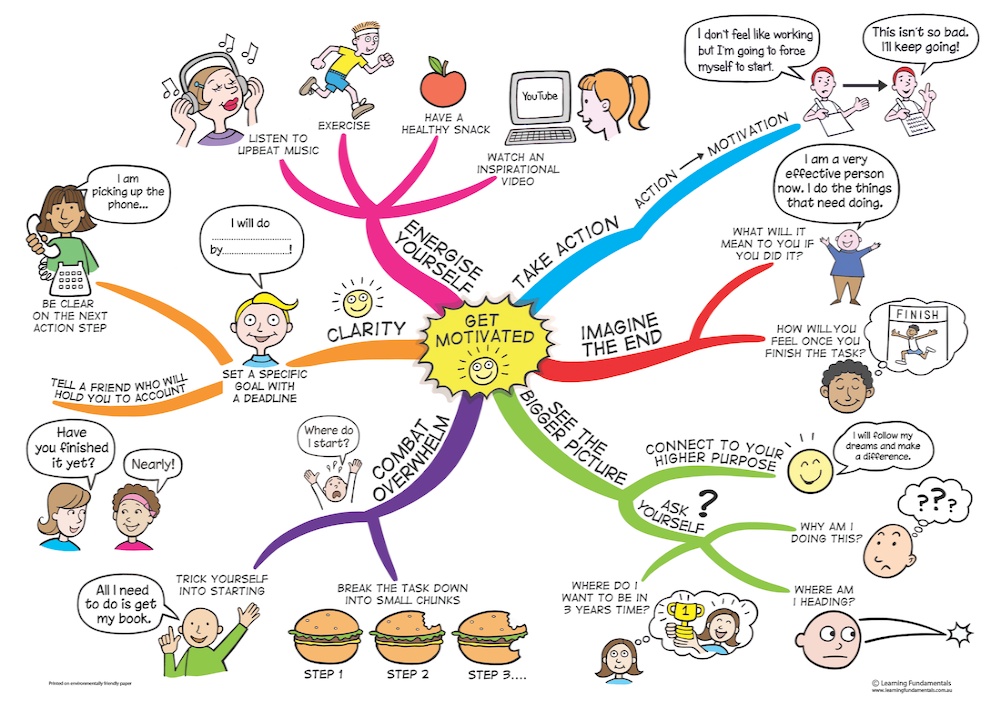
Have you been putting something off?
You know how it goes. One part of your brain says -
“Stop procrastinating. Just get on with it. Finish it!”
But then another part screams-
“But I don’t want to!”
It may not be anything major, but the task keeps niggling at the back of your mind. It can leave you feeling unsettled, slightly annoyed and stressed.
Here’s the thing: you can’t be fully at peace until you complete the task. Why? Because the Ziegarnik effect is in full swing. The Ziegarnik effect is the tendency we have to worry about something we have started and haven’t yet finished.
But if you can just get it done, your brain will breathe a sigh of relief. You will feel lighter. Chances are you will have turbocharged energy levels too.
As Jack Canfield states in his book “The Success Principles” –
So here are some ways to motivate yourself at anytime to complete tasks and projects you keep putting off-
Consider how life will be better

Whatever the task is – no matter how painful and boring – consider all the good things that will come once it’s finished.
Perhaps you will feel more energized as a result of being one step closer towards achieving a long term goal.
The benefit could simply be that you no longer feel bogged down by it. You can reclaim a little more peace of mind and energy for other new and exciting projects.
Scare yourself into action
A little fear can be a good source of motivation.
So ask yourself the question –
But there’s no point keeping your head in the sand and ignoring the consequences of never doing the task.
I want you to be in action. So be real with yourself – get clear on what the cost will be to your life and others.
If this is too hard to imagine, then think of the last time you put off doing something. How much fun was that? Were you happy with the end result? Chances are things could have been better and less stressful.
Nail your feet to the floor
If you need to complete a task at your desk, imagine that your feet are nailed to the floor and your pants are glued to your chair. You can’t leave your desk until you finish the task.
To do this requires self discipline, focus and strength. You need to be ruthless with yourself – finish the task and then you can experience complete freedom from your desk and chair.
Get your dopamine firing

To help you finish a particularly boring task, you need to get your dopamine firing. Dopamine is a neurotransmitter associated with the expectation of pleasurable experiences.
Now typically when your brain thinks of doing a boring project, dopamine isn’t released. The gates to your dopamine are firmly closed.
So how can you open up your dopamine floodgates?
By simply combining the task with some upbeat music that you really enjoy, people who you enjoy spending time with or your favourite café (go and order your favourite drink).
Triggering dopamine can help you to get tasks done and dusted. It helps the process be less painful too.
Identify why you can’t or won’t do it
Often we don’t take action on a task because we are stopped by mental barriers.
How do you tackle a mental barrier?
Take some time (say 2 – 5 minutes) to explore what is stopping you from taking action.
In my experience, when people get stopped it usually comes down to one of three things–
1. Lack of clarity – “I don’t know where to start”
2. Sense of overwhelm – “Argh! I feel overwhelmed by the size of the task”
3. Lack of skill/knowledge – “Help! I don’t know how to do this!”
Here’s how you can tackle each mental barrier –
The solution to lack of clarity

If you don’t know where to start, then start anywhere. Preferably, start with what is most appealing and interesting for you.
If you have to write an essay, don’t feel like you need to start with the first sentence. Start anywhere. Some writing is better than no writing. Just remember, you can’t edit a blank document. You need something to work with.
The solution to overwhelm
If you feel overwhelmed by the size of the task, break it down into really small bite size chunks. Ask yourself –
“What is the smallest action step I can take that will move me towards completing this task?”

You need to make things actionable for your brain. For instance, “pick up textbook” or “Find article on mindfulness and self control”. If the task is fuzzy or ill-defined, chances are you won’t do it.
The solution to not knowing how to do something
Finally, if you’re stopped because you don’t know how to do something – google it or ask someone who knows. You can save a lot of time and energy by doing this.
In the early days of doing my PhD I would spend hours (sometimes days) frustratingly reading books, trying to figure out how to do certain things for my research project. When I’d go meet with my supervisor, the issue would usually be resolved in a couple of minutes!
Your time is a finite resource so make the most of it.
Start before you feel ready
“I’ll just read one more article before I start writing this essay” or “I’m not motivated to start now but tomorrow things may be different” – does this sound familiar?
The reality is you are never going to feel ready or motivated to start doing some tasks. You just need to start.

As productivity coaches Hugh Kearns and Maria Gardiner state in their Nature article “Waiting for the motivation fairy” –
You know how it goes. One part of your brain says -
“Stop procrastinating. Just get on with it. Finish it!”
But then another part screams-
“But I don’t want to!”
It may not be anything major, but the task keeps niggling at the back of your mind. It can leave you feeling unsettled, slightly annoyed and stressed.
Here’s the thing: you can’t be fully at peace until you complete the task. Why? Because the Ziegarnik effect is in full swing. The Ziegarnik effect is the tendency we have to worry about something we have started and haven’t yet finished.
But if you can just get it done, your brain will breathe a sigh of relief. You will feel lighter. Chances are you will have turbocharged energy levels too.
As Jack Canfield states in his book “The Success Principles” –
“the quicker you move through [your] incompletes, the clearer your mind will be and the more “attention units” you’ll have to dedicate to those things that can really make a difference in your life”.At the very least, you’ll feel some relief as you go to cross the task off your ‘To do’ list.
So here are some ways to motivate yourself at anytime to complete tasks and projects you keep putting off-
Consider how life will be better

Whatever the task is – no matter how painful and boring – consider all the good things that will come once it’s finished.
Perhaps you will feel more energized as a result of being one step closer towards achieving a long term goal.
The benefit could simply be that you no longer feel bogged down by it. You can reclaim a little more peace of mind and energy for other new and exciting projects.
Scare yourself into action
A little fear can be a good source of motivation.
So ask yourself the question –
What is the cost (financial, social and emotional) of continuing to put this task off?You need to be careful with this strategy. Please don’t freak out. We all know that freaking out never helps. Too much fear can lead to paralysis.
But there’s no point keeping your head in the sand and ignoring the consequences of never doing the task.
I want you to be in action. So be real with yourself – get clear on what the cost will be to your life and others.
If this is too hard to imagine, then think of the last time you put off doing something. How much fun was that? Were you happy with the end result? Chances are things could have been better and less stressful.
Nail your feet to the floor
If you need to complete a task at your desk, imagine that your feet are nailed to the floor and your pants are glued to your chair. You can’t leave your desk until you finish the task.
To do this requires self discipline, focus and strength. You need to be ruthless with yourself – finish the task and then you can experience complete freedom from your desk and chair.
Get your dopamine firing

To help you finish a particularly boring task, you need to get your dopamine firing. Dopamine is a neurotransmitter associated with the expectation of pleasurable experiences.
Now typically when your brain thinks of doing a boring project, dopamine isn’t released. The gates to your dopamine are firmly closed.
So how can you open up your dopamine floodgates?
By simply combining the task with some upbeat music that you really enjoy, people who you enjoy spending time with or your favourite café (go and order your favourite drink).
Triggering dopamine can help you to get tasks done and dusted. It helps the process be less painful too.
Identify why you can’t or won’t do it
Often we don’t take action on a task because we are stopped by mental barriers.
How do you tackle a mental barrier?
Take some time (say 2 – 5 minutes) to explore what is stopping you from taking action.
In my experience, when people get stopped it usually comes down to one of three things–
1. Lack of clarity – “I don’t know where to start”
2. Sense of overwhelm – “Argh! I feel overwhelmed by the size of the task”
3. Lack of skill/knowledge – “Help! I don’t know how to do this!”
Here’s how you can tackle each mental barrier –
The solution to lack of clarity

If you don’t know where to start, then start anywhere. Preferably, start with what is most appealing and interesting for you.
If you have to write an essay, don’t feel like you need to start with the first sentence. Start anywhere. Some writing is better than no writing. Just remember, you can’t edit a blank document. You need something to work with.
The solution to overwhelm
If you feel overwhelmed by the size of the task, break it down into really small bite size chunks. Ask yourself –
“What is the smallest action step I can take that will move me towards completing this task?”

You need to make things actionable for your brain. For instance, “pick up textbook” or “Find article on mindfulness and self control”. If the task is fuzzy or ill-defined, chances are you won’t do it.
The solution to not knowing how to do something
Finally, if you’re stopped because you don’t know how to do something – google it or ask someone who knows. You can save a lot of time and energy by doing this.
In the early days of doing my PhD I would spend hours (sometimes days) frustratingly reading books, trying to figure out how to do certain things for my research project. When I’d go meet with my supervisor, the issue would usually be resolved in a couple of minutes!
Your time is a finite resource so make the most of it.
Start before you feel ready
“I’ll just read one more article before I start writing this essay” or “I’m not motivated to start now but tomorrow things may be different” – does this sound familiar?
The reality is you are never going to feel ready or motivated to start doing some tasks. You just need to start.

As productivity coaches Hugh Kearns and Maria Gardiner state in their Nature article “Waiting for the motivation fairy” –
“You have to start before you feel ready; then you’ll feel more motivated, and then you’ll take more action”Source: Link






.JPG)















